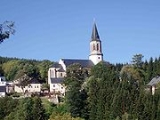
Johanngeorgenstadt
Encyclopedia
Johanngeorgenstadt is a mining town in Saxony
’s Ore Mountains
, 17 km south of Aue
, and 27 km northwest of Karlovy Vary
. It lies in the district of Erzgebirgskreis
, and right on the border
with the Czech Republic
, is a state-recognized health resort (Erholungsort), and calls itself Stadt des Schwibbogens (“Schwibbogen
Town”).
) or Plattenberg (in German
) and the 913-m-high Rabenberg.
, Eibenstock
and Sosa
. The Czech community of Potůčky
also borders on Johanngeorgenstadt.
 On 23 February 1654 in Annaburg
On 23 February 1654 in Annaburg
, the founding of Johanngeorgenstadt at the Fastenberg right on the border in the Amt of Schwarzenberg by Bohemian Exulanten (Protestant refugee
s) driven from Bergstadt Platten (now Horní Blatná
in the Czech Republic) was approved by Elector Johann Georg I
of Saxony. By 1680, there were roughly 100 ore mines in the town and the surrounding area. Silver
mining also branched into tin
mining, reaching its high point about 1715 and declining during the 18th century.
After the two free years were up in 1656, the Elector of Saxony gave up excise, “Schock” (an old currency in Saxony) and drinking taxes until the beginning of the 18th century owing to the pervasive poverty
in the town. The great famine
in the Ore Mountains in 1771 and 1772 claimed roughly 650 lives in Johanngeorgenstadt.
Already in 1651 in today’s constituent community of Wittigsthal, an ironworks
had come into service, and by 1828, Carl Gotthilf Nestler (1789–1864) had set up Saxony’s first fully functional iron plate rolling mill in the Haberlandmühle. In the 19th century also began the production of lace
bands and as of 1860, of leather
gloves. On 19 August 1867, a devastating great fire destroyed 287 of the town’s 355 houses and claimed seven adults’ and five children’s lives.
Germany’s first ski jump was built in 1929 near Johanngeorgenstadt. It bore the name “Hans-Heinz-Schanze”. In 1934, the formerly abandoned mining
industry was taken up again. In the Second World War, with the seizure of owner Arthur Krautmann’s “Deutsches Haus” hotel across from the railway station, the town became home to a military hospital
. Furthermore, the town harboured an outlying camp of the Flossenbürg concentration camp
in which countless inmates died. The Johanngeorgenstadt camp was emptied on 13 April 1945 and the inmates were sent on a death march
towards Theresienstadt.
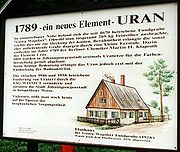 Beginning in 1945, through the founding of SAG Wismut and later SDAG Wismut
Beginning in 1945, through the founding of SAG Wismut and later SDAG Wismut
(Sowjetisch-Deutsche Aktiengesellschaft Wismut – Soviet-German Bismuth Corporation) uranium
mining underwent growth that was both rapid and without much regard to either human beings or the environment. A great deal of the Old Town had to be torn down between 1953 and 1960 owing to mining damage, and new residential area
s were built.
From 1952 to 1957, Johanngeorgenstadt was a district unto itself, but after this the town was integrated with the district of Schwarzenberg (now Aue-Schwarzenberg).
The closure that began in 1990 of many businesses, such as the glove, textile and furniture industries as well as machine building led to a great fall in the town’s population to levels below those before the war. This in turn led to the demolition of many empty factories and residential blocks (especially in Neuoberhaus, Pachthaus and the midtown). These measures even affected one of the town’s few cultural monuments: The mining warehouse building, built between 1806 and 1812 and spared by the great fire of 1867, was, with town council’s approval, torn down.
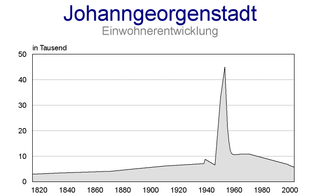 Development of population figures (from 1955 31 December):
Development of population figures (from 1955 31 December):
1 29 October
2 31 August
Of the 5,748 inhabitants on 31 December 2003, 2,751 were male and 2,997 female.
have their roots in the time when the town was founded.
Johanngeorgenstadt’s coat of arms might heraldically be described thus: Party per fess, above argent three buildings gules with towers, below gules an inescutcheon argent, therein a sledgehammer and a cross-peen hammer sable per saltire.
The official German blazon, however (“Geteilt von Silber über Rot; oben drei rote Gebäude mit Türmen, unten ein kleiner Silberschild, darin schwarze Schlägel und Eisen”), does not mention the black roofs seen in the sample coat of arms in this article, nor does it say exactly how the charge
s are to be configured. It does not say, for instance, that the tools in the inescutcheon should be crossed (note, however, that this is implied if they are described as “hammer and pick
”, the historical symbol of mining).
in Bavaria
, Germany Nejdek
(Neudek) in the Czech Republic
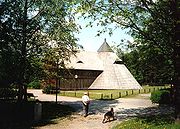 Not far from Schwefelwerkstraße lies the recreation, dedicated on 30 October 1993, of a horse gin and a hat house that may be visited. Right near the horse gin is a lapidarium featuring historic border stones and other boundary-marking stones.
Not far from Schwefelwerkstraße lies the recreation, dedicated on 30 October 1993, of a horse gin and a hat house that may be visited. Right near the horse gin is a lapidarium featuring historic border stones and other boundary-marking stones.
Likewise on Schwefelwerkstraße in the middle of town is a Heimat-Stube, a museum of local lore.
In the Bahnhofsgebäude (railway station building), built in 1898 and 1899 and remodelled after a fire in 1993, various exhibitions take place.
There is also an “educational and entertaining” visitor mine in Wittigsthal called “Frisch Glück”
comes from, although only one of the three musicians, Michael Rostig, actually still lives in town.
Within the Erzgebirgszweigverein, a singing group led by retired teacher Eberhard Müller is active.
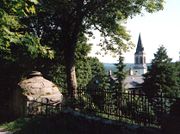
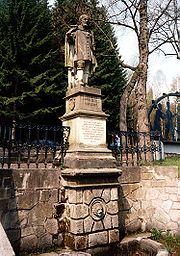 The Evangelical Lutheran Stadtkirche (“Town Church”) was built in neo-Gothic style using the old tower stonework after the town fire destroyed the Exulantenkirche from the 17th century, and it was consecrated on 27 August 1872. Inside are found, among other things, the monumental painting “Hausandacht” (“House Prayer”) – also known as “Betender Bergmann” (“Praying Miner”) and “Bergmannsglaube” (“Miner’s Belief”) – and “Exulantenschicksal” (“Exulants’ Fate”) by artist August Herrmann (1885–1962).
The Evangelical Lutheran Stadtkirche (“Town Church”) was built in neo-Gothic style using the old tower stonework after the town fire destroyed the Exulantenkirche from the 17th century, and it was consecrated on 27 August 1872. Inside are found, among other things, the monumental painting “Hausandacht” (“House Prayer”) – also known as “Betender Bergmann” (“Praying Miner”) and “Bergmannsglaube” (“Miner’s Belief”) – and “Exulantenschicksal” (“Exulants’ Fate”) by artist August Herrmann (1885–1962).
At the marketplace
stands the Statue of the Town’s Founder, Elector Johann Georg I of Saxony (1585–1656). It was carved out of Postelwitz sandstone
in 1863 by sculptor Wilhelm Schwenk from Dresden
and restored in 1984. Before it are some granite
steps and a water-spouting bear’s head referring to the Electoral hunts in the town’s environs.
Also at the marketplace, the Schillerbrunnen (“Schiller Fountain”) is to be found. This was built in 1859, and dedicated on Friedrich von Schiller’s one hundredth birthday.
Other memorials at the marketplace are the light grey granite pedestal of the Warriors’ Memorial (1870/71) and several memorial stones to the sons of the town. The two-metre-tall bronze
figure formerly on the Warriors’ Memorial pedestal was melted down in the Second World War.
At the corner of the marketplace at Karlsbader Straße once stood, until the town fire in 1867, the Löbelhaus in which the town’s first mayor Johann Löbel the Elder lived. Here, in August 1785 Johann Wolfgang von Goethe
spent the night on his way to Karlsbad (now Karlovy Vary in the Czech Republic).
At Röderplatz is found the memorial dedicated on 8 September 1901 to the Ore Mountain poet and singer, school principal Christian Friedrich Röder (1827–1900); it includes a larger-than-life bust.
Also worth seeing is the Platz des Bergmanns (“Miner’s Square”) with its music pavilion.
In the New Town (Neustadt) stands a Saxony postal milestone
from 1728, which once stood at the market.
In Wittigsthal, next to the border crossing and the visitor mine, is the mansion of the old Wittigsthal ironworks, from 1836.

The cross-country skiing
centre in Schwefelwerk was completed in 2004 with a new building and recognized as a Nordic-Aktiv-Zentrum of the German Skiing Federation. Here begins the ridge ski run by way of Weitersglashütte and Mühlleithen to Schöneck, much loved in winter. Furthermore, in the Külliggut lands there are lifts at skiers’ disposal.
The widely wooded surroundings offer hiking
enthusiasts a broad area for their pastime. Many marked trails lead to local sightseeing spots, among them in particular the Anton-Günther-Weg, which was dedicated in 1995 and which crosses the border
. Also popular are outings to the Czech Republic, among these a trip to the 1043-m-high Plattenberg.

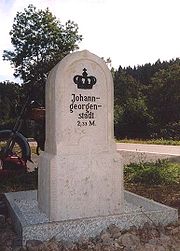
 Johanngeorgenstadt was included in the postal road system of the Electorate of Saxony
Johanngeorgenstadt was included in the postal road system of the Electorate of Saxony
as the town lay on a pass
in the Ore Mountains. Hearkening back to this time are the postal milestone
from 1728 before the post office
in the New Town (Neustadt), although originally it stood at the marketplace, and also a full milestone opposite the powder tower and a quarter-mile stone in Steinbach, both of which date from 1725. There are furthermore several Kingdom of Saxony
milestones near the town that were placed from 1858 onwards, for example on the old postal route from Auerbach by way of Carlsfeld and Wildenthal (today part of Eibenstock
) to Johanngeorgenstadt.
In 1883, the railway to Schwarzenberg began running, and from 1899 until its closure in 1945 the railway ran through to Neudek (Nejdek
) and Karlsbad (Karlovy Vary). There are bus
connections to Schwarzenberg and by way of Eibenstock to Rodewisch
. With the reopening of the railway on 30 June 1991 and the opening of a pedestrian border crossing, which may also be used by motorscooters, it became possible to reach the neighbouring Czech community of Potůčky (Breitenbach).
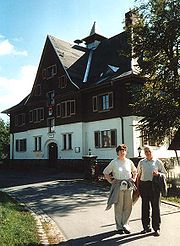 The Rathaus (Town Hall) is housed in a former barracks
The Rathaus (Town Hall) is housed in a former barracks
building on Eibenstocker Straße in the middle of town. The old town hall lay right on the marketplace, but it was destroyed in the great fire of 1867, and its successor was torn down in 1955.
Right near the town administration is the Haus der Jugend (House of Youth) built in 2004.
The Kulturhaus Karl Marx
built in the New Town (Neustadt) in 1956 has been shut down for many years.
Since 1927, at Hospitalstraße 5, there has been a youth hostel with 60 beds at its disposal. In 1986, the title “Most Beautiful Youth Hostel” (Schönste Jugendherberge) was bestowed upon it. Until 1990, the hostel bore the name Ernst Schneller, after a prewar Communist
member of the Reichstag
who died at the Sachsenhausen concentration camp
.
The gym
nasium built in 1930 and 1931 on Eibenstocker Straße was opened once again in late October 2004 as the Franz Mehring
Sport and Meeting Place after renovation and expansion.
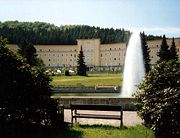
Saxony
The Free State of Saxony is a landlocked state of Germany, contingent with Brandenburg, Saxony Anhalt, Thuringia, Bavaria, the Czech Republic and Poland. It is the tenth-largest German state in area, with of Germany's sixteen states....
’s Ore Mountains
Ore Mountains
The Ore Mountains in Central Europe have formed a natural border between Saxony and Bohemia for many centuries. Today, the border between Germany and the Czech Republic runs just north of the main crest of the mountain range...
, 17 km south of Aue
Aue
Aue is a small town in Germany at the outlet of the river Schwarzwasser into the river Mulde in the Ore Mountains, and has roughly 18,000 inhabitants. Aue was the administrative seat of the former district of Aue-Schwarzenberg in Saxony, and is part of the Erzgebirgskreis since August 2008...
, and 27 km northwest of Karlovy Vary
Karlovy Vary
Karlovy Vary is a spa city situated in western Bohemia, Czech Republic, on the confluence of the rivers Ohře and Teplá, approximately west of Prague . It is named after King of Bohemia and Holy Roman Emperor Charles IV, who founded the city in 1370...
. It lies in the district of Erzgebirgskreis
Erzgebirgskreis
Erzgebirgskreis is a district in the Free State of Saxony, Germany. It is named after the Erzgebirge , a mountain range in the southern part of the district which forms part of the Germany–Czech Republic border...
, and right on the border
Border
Borders define geographic boundaries of political entities or legal jurisdictions, such as governments, sovereign states, federated states and other subnational entities. Some borders—such as a state's internal administrative borders, or inter-state borders within the Schengen Area—are open and...
with the Czech Republic
Czech Republic
The Czech Republic is a landlocked country in Central Europe. The country is bordered by Poland to the northeast, Slovakia to the east, Austria to the south, and Germany to the west and northwest....
, is a state-recognized health resort (Erholungsort), and calls itself Stadt des Schwibbogens (“Schwibbogen
Schwibbogen
A Schwibbogen is a decorative candle-holder from the Ore Mountains region of Saxony, Germany.The first metal Schwibbogen was made in 1740 in Johanngeorgenstadt. The early candle arches always consisted of black ore. They were made out of one single forged piece and could be painted. The number of...
Town”).
Location
The town stretches predominantly from the eastern ridge of the almost 900-m-high Fastenberg to where the Breitenbach, which forms part of the border with the Czech Republic, empties into the river Schwarzwasser. The nearest high mountains to the town are the 1019-m-high Auersberg, the 1043-m-high Blatenský vrch (in CzechCzech language
Czech is a West Slavic language with about 12 million native speakers; it is the majority language in the Czech Republic and spoken by Czechs worldwide. The language was known as Bohemian in English until the late 19th century...
) or Plattenberg (in German
German language
German is a West Germanic language, related to and classified alongside English and Dutch. With an estimated 90 – 98 million native speakers, German is one of the world's major languages and is the most widely-spoken first language in the European Union....
) and the 913-m-high Rabenberg.
Neighbouring communities
Communities in Aue-Schwarzenberg bordering on Johanngeorgenstadt are BreitenbrunnBreitenbrunn, Saxony
Breitenbrunn is a community in the Ore Mountains in the district of Erzgebirgskreis in the Free State of Saxony in Germany.- Constituent communities :...
, Eibenstock
Eibenstock
Eibenstock is a town in the western Ore Mountains, in the Erzgebirgskreis, Saxony, Germany. It is situated near the river Mulde.- Geography :...
and Sosa
Sosa
Sosa may refer to:*a Spanish surname. Famous Sosas include:** Alex Sosa, a fictional drug lord from the 1983 film Scarface** Arlenis Sosa, Dominican Model** David Sosa, American philosopher, son of Ernest Sosa...
. The Czech community of Potůčky
Potůčky
Potůčky is a village and municipality in Karlovy Vary District in the Karlovy Vary Region of the Czech Republic.-Notes:...
also borders on Johanngeorgenstadt.
Constituent communities
Johanngeorgenstadt consists of the centres of Altstadt (called locally Sockendorf), Mittelstadt, Neustadt, Schwefelwerk, Jugel (Ober- and Unterjugel), Henneberg, Wittigsthal, Pachthaus, Heimberg (with Külliggut), Steigerdorf (with Haberlandmühle), Steinbach and Sauschwemme. The former centre of Neuoberhaus is nowadays abandoned and has been overgrown by woods.Climate
Owing to the town’s great elevation – the road to Neustadt reaches 892 m – the winter here, with its long-lasting snow cover, often lasts half the year, making Johanngeorgenstadt one of Saxony’s snowiest areas. Wind strengths of four to seven at any time of year are not a rarity, leading to the town’s already becoming a well-loved summer resort by the late 19th century. Ever since the area was once mentioned in some 18th-century publications as the Sächsisches Sibirien (“Saxon Siberia”), the town has been known by the affectionate nickname Johannsibirsk.History

Annaburg
Annaburg is a small town in Wittenberg district in Saxony-Anhalt, Germany. It was the seat of the former Verwaltungsgemeinschaft Annaburg-Prettin.- Constituent communities :Annaburg has two centres, one also called Annaburg, and the other Purzien....
, the founding of Johanngeorgenstadt at the Fastenberg right on the border in the Amt of Schwarzenberg by Bohemian Exulanten (Protestant refugee
Refugee
A refugee is a person who outside her country of origin or habitual residence because she has suffered persecution on account of race, religion, nationality, political opinion, or because she is a member of a persecuted 'social group'. Such a person may be referred to as an 'asylum seeker' until...
s) driven from Bergstadt Platten (now Horní Blatná
Horní Blatná
Horní Blatná is a town in the Czech Republic.The economic situation of the town was bolstered by opening of the railway line Karlovy Vary–Johanngeorgenstadt in 1899.-External links:*...
in the Czech Republic) was approved by Elector Johann Georg I
John George I, Elector of Saxony
John George I was Elector of Saxony from 1611 to 1656.-Biography:Born in Dresden, he was the second son of the Elector Christian I and Sophie of Brandenburg....
of Saxony. By 1680, there were roughly 100 ore mines in the town and the surrounding area. Silver
Silver
Silver is a metallic chemical element with the chemical symbol Ag and atomic number 47. A soft, white, lustrous transition metal, it has the highest electrical conductivity of any element and the highest thermal conductivity of any metal...
mining also branched into tin
Tin
Tin is a chemical element with the symbol Sn and atomic number 50. It is a main group metal in group 14 of the periodic table. Tin shows chemical similarity to both neighboring group 14 elements, germanium and lead and has two possible oxidation states, +2 and the slightly more stable +4...
mining, reaching its high point about 1715 and declining during the 18th century.
After the two free years were up in 1656, the Elector of Saxony gave up excise, “Schock” (an old currency in Saxony) and drinking taxes until the beginning of the 18th century owing to the pervasive poverty
Poverty
Poverty is the lack of a certain amount of material possessions or money. Absolute poverty or destitution is inability to afford basic human needs, which commonly includes clean and fresh water, nutrition, health care, education, clothing and shelter. About 1.7 billion people are estimated to live...
in the town. The great famine
Famine
A famine is a widespread scarcity of food, caused by several factors including crop failure, overpopulation, or government policies. This phenomenon is usually accompanied or followed by regional malnutrition, starvation, epidemic, and increased mortality. Every continent in the world has...
in the Ore Mountains in 1771 and 1772 claimed roughly 650 lives in Johanngeorgenstadt.
Already in 1651 in today’s constituent community of Wittigsthal, an ironworks
Ironworks
An ironworks or iron works is a building or site where iron is smelted and where heavy iron and/or steel products are made. The term is both singular and plural, i.e...
had come into service, and by 1828, Carl Gotthilf Nestler (1789–1864) had set up Saxony’s first fully functional iron plate rolling mill in the Haberlandmühle. In the 19th century also began the production of lace
Lace
Lace is an openwork fabric, patterned with open holes in the work, made by machine or by hand. The holes can be formed via removal of threads or cloth from a previously woven fabric, but more often open spaces are created as part of the lace fabric. Lace-making is an ancient craft. True lace was...
bands and as of 1860, of leather
Leather
Leather is a durable and flexible material created via the tanning of putrescible animal rawhide and skin, primarily cattlehide. It can be produced through different manufacturing processes, ranging from cottage industry to heavy industry.-Forms:...
gloves. On 19 August 1867, a devastating great fire destroyed 287 of the town’s 355 houses and claimed seven adults’ and five children’s lives.
Germany’s first ski jump was built in 1929 near Johanngeorgenstadt. It bore the name “Hans-Heinz-Schanze”. In 1934, the formerly abandoned mining
Mining
Mining is the extraction of valuable minerals or other geological materials from the earth, from an ore body, vein or seam. The term also includes the removal of soil. Materials recovered by mining include base metals, precious metals, iron, uranium, coal, diamonds, limestone, oil shale, rock...
industry was taken up again. In the Second World War, with the seizure of owner Arthur Krautmann’s “Deutsches Haus” hotel across from the railway station, the town became home to a military hospital
Military hospital
Military hospital is a hospital, which is generally located on a military base and is reserved for the use of military personnel, their dependents or other authorized users....
. Furthermore, the town harboured an outlying camp of the Flossenbürg concentration camp
Flossenbürg concentration camp
Konzentrationslager Flossenbürg was a Nazi concentration camp built in May 1938 by the Schutzstaffel Economic-Administrative Main Office at Flossenbürg, in the Oberpfalz region of Bavaria, Germany, near the border with Czechoslovakia. Until its liberation in April 1945, more than 96,000 prisoners...
in which countless inmates died. The Johanngeorgenstadt camp was emptied on 13 April 1945 and the inmates were sent on a death march
Death march
A death march is a forced march of prisoners of war or other captives or deportees. Those marching must walk over long distances for an extremely long period of time and are not supplied with food or water...
towards Theresienstadt.

SDAG Wismut
The SAG/SDAG Wismut was a uranium mining company in East Germany producing 230,400 tonnes of uranium between 1947 and 1990. In 1991 it was transformed into the Wismut GmbH owned by the state of Germany which is now responsible for the recultivation of the former mining and milling areas...
(Sowjetisch-Deutsche Aktiengesellschaft Wismut – Soviet-German Bismuth Corporation) uranium
Uranium
Uranium is a silvery-white metallic chemical element in the actinide series of the periodic table, with atomic number 92. It is assigned the chemical symbol U. A uranium atom has 92 protons and 92 electrons, of which 6 are valence electrons...
mining underwent growth that was both rapid and without much regard to either human beings or the environment. A great deal of the Old Town had to be torn down between 1953 and 1960 owing to mining damage, and new residential area
Residential area
A residential area is a land use in which housing predominates, as opposed to industrial and commercial areas.Housing may vary significantly between, and through, residential areas. These include single family housing, multi-family residential, or mobile homes. Zoning for residential use may permit...
s were built.
From 1952 to 1957, Johanngeorgenstadt was a district unto itself, but after this the town was integrated with the district of Schwarzenberg (now Aue-Schwarzenberg).
The closure that began in 1990 of many businesses, such as the glove, textile and furniture industries as well as machine building led to a great fall in the town’s population to levels below those before the war. This in turn led to the demolition of many empty factories and residential blocks (especially in Neuoberhaus, Pachthaus and the midtown). These measures even affected one of the town’s few cultural monuments: The mining warehouse building, built between 1806 and 1812 and spared by the great fire of 1867, was, with town council’s approval, torn down.
Population development

1815 to 1946
|
1950 to 1971
|
1974 to 2006
|
- Source from 1946 to 1976 (except 1953): Statistische Jahrbücher der Deutschen Demokratischen Republik
- Source from 1998: Statistisches Landesamt des Freistaates Sachsen
1 29 October
2 31 August
Of the 5,748 inhabitants on 31 December 2003, 2,751 were male and 2,997 female.
Coat of arms
The town’s armsCoat of arms
A coat of arms is a unique heraldic design on a shield or escutcheon or on a surcoat or tabard used to cover and protect armour and to identify the wearer. Thus the term is often stated as "coat-armour", because it was anciently displayed on the front of a coat of cloth...
have their roots in the time when the town was founded.
Johanngeorgenstadt’s coat of arms might heraldically be described thus: Party per fess, above argent three buildings gules with towers, below gules an inescutcheon argent, therein a sledgehammer and a cross-peen hammer sable per saltire.
The official German blazon, however (“Geteilt von Silber über Rot; oben drei rote Gebäude mit Türmen, unten ein kleiner Silberschild, darin schwarze Schlägel und Eisen”), does not mention the black roofs seen in the sample coat of arms in this article, nor does it say exactly how the charge
Charge (heraldry)
In heraldry, a charge is any emblem or device occupying the field of an escutcheon . This may be a geometric design or a symbolic representation of a person, animal, plant, object or other device...
s are to be configured. It does not say, for instance, that the tools in the inescutcheon should be crossed (note, however, that this is implied if they are described as “hammer and pick
Hammer and pick
The hammer and pick is a symbol representing the industrialised working classes, similar to the more famous hammer and sickle. It was used in the flag of the Marxist People's Republic of Congo between 1970 and 1991....
”, the historical symbol of mining).
Town partnerships
BurglengenfeldBurglengenfeld
Burglengenfeld is a town in the district of Schwandorf, in Bavaria, Germany. It is situated on the river Naab, 22 km north of Regensburg....
in Bavaria
Bavaria
Bavaria, formally the Free State of Bavaria is a state of Germany, located in the southeast of Germany. With an area of , it is the largest state by area, forming almost 20% of the total land area of Germany...
, Germany Nejdek
Nejdek
Nejdek is a town in the Karlovy Vary Region, Czech Republic....
(Neudek) in the Czech Republic
Czech Republic
The Czech Republic is a landlocked country in Central Europe. The country is bordered by Poland to the northeast, Slovakia to the east, Austria to the south, and Germany to the west and northwest....
Museums

Likewise on Schwefelwerkstraße in the middle of town is a Heimat-Stube, a museum of local lore.
In the Bahnhofsgebäude (railway station building), built in 1898 and 1899 and remodelled after a fire in 1993, various exhibitions take place.
There is also an “educational and entertaining” visitor mine in Wittigsthal called “Frisch Glück”
Music
Johanngeorgenstadt is where the Ore Mountain folk group De RandfichtenDe Randfichten
De Randfichten are a German Volksmusic band from Johanngeorgenstadt, Saxony.Founded in 1992 as Original Arzgebirgische Randfichten by Thomas "Rups" Unger and Michael "Michl" Rostig, they were renamed to De Randfichten in 1997. In that year Thomas "Lauti" Lauterbach became a band member, and they...
comes from, although only one of the three musicians, Michael Rostig, actually still lives in town.
Within the Erzgebirgszweigverein, a singing group led by retired teacher Eberhard Müller is active.
Buildings


At the marketplace
Marketplace
A marketplace is the space, actual, virtual or metaphorical, in which a market operates. The term is also used in a trademark law context to denote the actual consumer environment, ie. the 'real world' in which products and services are provided and consumed.-Marketplaces and street markets:A...
stands the Statue of the Town’s Founder, Elector Johann Georg I of Saxony (1585–1656). It was carved out of Postelwitz sandstone
Sandstone
Sandstone is a sedimentary rock composed mainly of sand-sized minerals or rock grains.Most sandstone is composed of quartz and/or feldspar because these are the most common minerals in the Earth's crust. Like sand, sandstone may be any colour, but the most common colours are tan, brown, yellow,...
in 1863 by sculptor Wilhelm Schwenk from Dresden
Dresden
Dresden is the capital city of the Free State of Saxony in Germany. It is situated in a valley on the River Elbe, near the Czech border. The Dresden conurbation is part of the Saxon Triangle metropolitan area....
and restored in 1984. Before it are some granite
Granite
Granite is a common and widely occurring type of intrusive, felsic, igneous rock. Granite usually has a medium- to coarse-grained texture. Occasionally some individual crystals are larger than the groundmass, in which case the texture is known as porphyritic. A granitic rock with a porphyritic...
steps and a water-spouting bear’s head referring to the Electoral hunts in the town’s environs.
Also at the marketplace, the Schillerbrunnen (“Schiller Fountain”) is to be found. This was built in 1859, and dedicated on Friedrich von Schiller’s one hundredth birthday.
Other memorials at the marketplace are the light grey granite pedestal of the Warriors’ Memorial (1870/71) and several memorial stones to the sons of the town. The two-metre-tall bronze
Bronze
Bronze is a metal alloy consisting primarily of copper, usually with tin as the main additive. It is hard and brittle, and it was particularly significant in antiquity, so much so that the Bronze Age was named after the metal...
figure formerly on the Warriors’ Memorial pedestal was melted down in the Second World War.
At the corner of the marketplace at Karlsbader Straße once stood, until the town fire in 1867, the Löbelhaus in which the town’s first mayor Johann Löbel the Elder lived. Here, in August 1785 Johann Wolfgang von Goethe
Johann Wolfgang von Goethe
Johann Wolfgang von Goethe was a German writer, pictorial artist, biologist, theoretical physicist, and polymath. He is considered the supreme genius of modern German literature. His works span the fields of poetry, drama, prose, philosophy, and science. His Faust has been called the greatest long...
spent the night on his way to Karlsbad (now Karlovy Vary in the Czech Republic).
At Röderplatz is found the memorial dedicated on 8 September 1901 to the Ore Mountain poet and singer, school principal Christian Friedrich Röder (1827–1900); it includes a larger-than-life bust.
Also worth seeing is the Platz des Bergmanns (“Miner’s Square”) with its music pavilion.
In the New Town (Neustadt) stands a Saxony postal milestone
Milestone
A milestone is one of a series of numbered markers placed along a road or boundary at intervals of one mile or occasionally, parts of a mile. They are typically located at the side of the road or in a median. They are alternatively known as mile markers, mileposts or mile posts...
from 1728, which once stood at the market.
In Wittigsthal, next to the border crossing and the visitor mine, is the mansion of the old Wittigsthal ironworks, from 1836.
Natural monuments

- Kleiner Kranichsee conservation area (high moorMoorlandMoorland or moor is a type of habitat, in the temperate grasslands, savannas, and shrublands biome, found in upland areas, characterised by low-growing vegetation on acidic soils and heavy fog...
with viewing platform) in Henneberg - Auersberg (1 019 m) with viewing tower and mountain hotel
- “Himmelswiese” conservation area near Breitenbrunn-Halbemeile
- Preißhausbuche on the old postal road to Breitenbrunn
Sport
A Naturbad (“natural” swimming pool), fed by the Schwefelbach, draws summertime visitors. The natural ice stadium not far from the pool at the ski jumps is open in the wintertime.The cross-country skiing
Cross-country skiing
Cross-country skiing is a winter sport in which participants propel themselves across snow-covered terrain using skis and poles...
centre in Schwefelwerk was completed in 2004 with a new building and recognized as a Nordic-Aktiv-Zentrum of the German Skiing Federation. Here begins the ridge ski run by way of Weitersglashütte and Mühlleithen to Schöneck, much loved in winter. Furthermore, in the Külliggut lands there are lifts at skiers’ disposal.
The widely wooded surroundings offer hiking
Hiking
Hiking is an outdoor activity which consists of walking in natural environments, often in mountainous or other scenic terrain. People often hike on hiking trails. It is such a popular activity that there are numerous hiking organizations worldwide. The health benefits of different types of hiking...
enthusiasts a broad area for their pastime. Many marked trails lead to local sightseeing spots, among them in particular the Anton-Günther-Weg, which was dedicated in 1995 and which crosses the border
Border
Borders define geographic boundaries of political entities or legal jurisdictions, such as governments, sovereign states, federated states and other subnational entities. Some borders—such as a state's internal administrative borders, or inter-state borders within the Schengen Area—are open and...
. Also popular are outings to the Czech Republic, among these a trip to the 1043-m-high Plattenberg.
Regular events

- January: Grenzlauf (Border Walk)
- Faschingszeit (Shrovetide): various events for townsfolk and visitors
- 23 February: Town’s founding day with mining parade and service at the town church
- March: Auersberglauf (Auersberg Walk)
- July: Gugler Fast
- August: Old Town Festival in “Sockendorf”
- Third weekend in AdventAdventAdvent is a season observed in many Western Christian churches, a time of expectant waiting and preparation for the celebration of the Nativity of Jesus at Christmas. It is the beginning of the Western liturgical year and commences on Advent Sunday, called Levavi...
: Schwibbogenfest (Christmas market) - Hardcore band New Morality played a show here on February 28, 2009, it has since become an annual local holiday
Transport


Electorate of Saxony
The Electorate of Saxony , sometimes referred to as Upper Saxony, was a State of the Holy Roman Empire. It was established when Emperor Charles IV raised the Ascanian duchy of Saxe-Wittenberg to the status of an Electorate by the Golden Bull of 1356...
as the town lay on a pass
Mountain pass
A mountain pass is a route through a mountain range or over a ridge. If following the lowest possible route, a pass is locally the highest point on that route...
in the Ore Mountains. Hearkening back to this time are the postal milestone
Milestone
A milestone is one of a series of numbered markers placed along a road or boundary at intervals of one mile or occasionally, parts of a mile. They are typically located at the side of the road or in a median. They are alternatively known as mile markers, mileposts or mile posts...
from 1728 before the post office
Post office
A post office is a facility forming part of a postal system for the posting, receipt, sorting, handling, transmission or delivery of mail.Post offices offer mail-related services such as post office boxes, postage and packaging supplies...
in the New Town (Neustadt), although originally it stood at the marketplace, and also a full milestone opposite the powder tower and a quarter-mile stone in Steinbach, both of which date from 1725. There are furthermore several Kingdom of Saxony
Kingdom of Saxony
The Kingdom of Saxony , lasting between 1806 and 1918, was an independent member of a number of historical confederacies in Napoleonic through post-Napoleonic Germany. From 1871 it was part of the German Empire. It became a Free state in the era of Weimar Republic in 1918 after the end of World War...
milestones near the town that were placed from 1858 onwards, for example on the old postal route from Auerbach by way of Carlsfeld and Wildenthal (today part of Eibenstock
Eibenstock
Eibenstock is a town in the western Ore Mountains, in the Erzgebirgskreis, Saxony, Germany. It is situated near the river Mulde.- Geography :...
) to Johanngeorgenstadt.
In 1883, the railway to Schwarzenberg began running, and from 1899 until its closure in 1945 the railway ran through to Neudek (Nejdek
Nejdek
Nejdek is a town in the Karlovy Vary Region, Czech Republic....
) and Karlsbad (Karlovy Vary). There are bus
Bus
A bus is a road vehicle designed to carry passengers. Buses can have a capacity as high as 300 passengers. The most common type of bus is the single-decker bus, with larger loads carried by double-decker buses and articulated buses, and smaller loads carried by midibuses and minibuses; coaches are...
connections to Schwarzenberg and by way of Eibenstock to Rodewisch
Rodewisch
Rodewisch is a town in the Vogtlandkreis district, in the Free State of Saxony, Germany. It is situated 3 km north of Auerbach , and 20 km east of Plauen.-Famous people born in Rodewisch:...
. With the reopening of the railway on 30 June 1991 and the opening of a pedestrian border crossing, which may also be used by motorscooters, it became possible to reach the neighbouring Czech community of Potůčky (Breitenbach).
Public institutions

Barracks
Barracks are specialised buildings for permanent military accommodation; the word may apply to separate housing blocks or to complete complexes. Their main object is to separate soldiers from the civilian population and reinforce discipline, training and esprit de corps. They were sometimes called...
building on Eibenstocker Straße in the middle of town. The old town hall lay right on the marketplace, but it was destroyed in the great fire of 1867, and its successor was torn down in 1955.
Right near the town administration is the Haus der Jugend (House of Youth) built in 2004.
The Kulturhaus Karl Marx
Karl Marx
Karl Heinrich Marx was a German philosopher, economist, sociologist, historian, journalist, and revolutionary socialist. His ideas played a significant role in the development of social science and the socialist political movement...
built in the New Town (Neustadt) in 1956 has been shut down for many years.
Since 1927, at Hospitalstraße 5, there has been a youth hostel with 60 beds at its disposal. In 1986, the title “Most Beautiful Youth Hostel” (Schönste Jugendherberge) was bestowed upon it. Until 1990, the hostel bore the name Ernst Schneller, after a prewar Communist
Communist Party of Germany
The Communist Party of Germany was a major political party in Germany between 1918 and 1933, and a minor party in West Germany in the postwar period until it was banned in 1956...
member of the Reichstag
Reichstag (Weimar Republic)
The Reichstag was the parliament of Weimar Republic .German constitution commentators consider only the Reichstag and now the Bundestag the German parliament. Another organ deals with legislation too: in 1867-1918 the Bundesrat, in 1919–1933 the Reichsrat and from 1949 on the Bundesrat...
who died at the Sachsenhausen concentration camp
Sachsenhausen concentration camp
Sachsenhausen or Sachsenhausen-Oranienburg was a Nazi concentration camp in Oranienburg, Germany, used primarily for political prisoners from 1936 to the end of the Third Reich in May, 1945. After World War II, when Oranienburg was in the Soviet Occupation Zone, the structure was used as an NKVD...
.
The gym
Gym
The word γυμνάσιον was used in Ancient Greece, that mean a locality for both physical and intellectual education of young men...
nasium built in 1930 and 1931 on Eibenstocker Straße was opened once again in late October 2004 as the Franz Mehring
Franz Mehring
Franz Erdmann Mehring , was a German publicist, politician and historian.-Early years:Franz Mehring was born 27 February 1846 in Schlawe, Pomerania, the son of a bourgeois family.-Political career:...
Sport and Meeting Place after renovation and expansion.
Education
- Primary school, Schulstr. 15
- Kurfürst-Johann-Georg-Schule, Käthe-Kollwitz-Str. 16
Honorary citizens
- 1665: Johann Löbel the Elder (1592–1666), first mayor, granted exemption from duty for his house by the Saxon Elector
- 1680: Matthäus Allius (1632–1701), town judge, granted Electoral house privilege throughout the town for merit
- 1865: Wilhelm FischerWilhelm FischerWilhelm "Willi" Fischer boxer, Germany at the 1992 Summer Olympics Barcelona, Spain. Nicknamed The Ox Ahmed Sarir Jerry Nijman super heavyweight Bulgaria's Svilen Rusinov....
(1796–1884), 1827–1835 mining master in Johanngeorgenstadt, made an endowment of 300 ThalerThalerThe Thaler was a silver coin used throughout Europe for almost four hundred years. Its name lives on in various currencies as the dollar or tolar. Etymologically, "Thaler" is an abbreviation of "Joachimsthaler", a coin type from the city of Joachimsthal in Bohemia, where some of the first such...
s for the Haldensluster Gestift - 1868: Bernhard von Uhde, district director in ZwickauZwickauZwickau in Germany, former seat of the government of the south-western region of the Free State of Saxony, belongs to an industrial and economical core region. Nowadays it is the capital city of the district of Zwickau...
, took it upon himself to quickly remove the 1867 fire damage - 1869: Friedrich August Weidauer (d. 1897), Mayor of Schwarzenberg, helped with the rebuilding of Town Hall
- 1869: Heinrich Moritz Reichelt (d. 1886) mine surveyor in Schwarzenberg, endowed the town church’s baptismal font and Bergglocke (“Mountain Bell”)
- 1870: Ernst Adolph Theodor Degen (1782–1854), apothecaryApothecaryApothecary is a historical name for a medical professional who formulates and dispenses materia medica to physicians, surgeons and patients — a role now served by a pharmacist and some caregivers....
and mayor, helped with the town’s reconstruction - 1874: Konrad Eduard Löhr (d. 1890), Mayor of BautzenBautzenBautzen is a hill-top town in eastern Saxony, Germany, and administrative centre of the eponymous district. It is located on the Spree River. As of 2008, its population is 41,161...
, LandtagLandtagA Landtag is a representative assembly or parliament in German-speaking countries with some legislative authority.- Name :...
secretary, worked to have the railway built - 1874: Heinrich Otto von Erdmannsdorff (1815–1888), Lord of Schönfeld, Member of the Landtag, supported the building of the railway
- 1874: F. O. Starke, Member of the Second Ständekammer, furthered railway building from Schwarzenberg to Johanngeorgenstadt
- 1874: Mehnert, Commissar and Member of the Landtag, worked to have the railway built to Johanngeorgenstadt
- 1874: Karl Eduard Mannsfeld, court director in Schwarzenberg, Member of the Second Ständekammer, furthered railway building
- 1874: Friedrich Wilhelm Pfotenhauer (1812–1877), Oberbürgermeister of the City of Dresden, furthered railway building
- 1878: Christian Adolf Lenk (1801–1879), cantorCantor (church)A cantor is the chief singer employed in a church with responsibilities for the ecclesiastical choir; also called the precentor....
, deaconDeaconDeacon is a ministry in the Christian Church that is generally associated with service of some kind, but which varies among theological and denominational traditions...
and minister, saved the church books from the town fire - 1880: Léonce Robert Freiherr von Könneritz (1835–1890), Saxon Finance Minister, furthered railway building
- 1880: Gustav Adolf Vodel, Secret Government Councillor and District Captain in Zwickau, supported the railway connection
- 1889: Karl August Seifert, town councillor and schooling supporter
- 1895: Prince Otto von BismarckOtto von BismarckOtto Eduard Leopold, Prince of Bismarck, Duke of Lauenburg , simply known as Otto von Bismarck, was a Prussian-German statesman whose actions unified Germany, made it a major player in world affairs, and created a balance of power that kept Europe at peace after 1871.As Minister President of...
(1815–1898), Imperial Chancellor, supported reconstruction after the fire of 1867 - 1901: Karl Anton Unger (1831–1909), factory owner in DresdenDresdenDresden is the capital city of the Free State of Saxony in Germany. It is situated in a valley on the River Elbe, near the Czech border. The Dresden conurbation is part of the Saxon Triangle metropolitan area....
, donated much money for the town and the women’s club - 1911: Otto Robert Georgi (1831–1918), Oberbürgermeister of the City of Leipzig, endower of the Miners’ Widows’ Fund
- 1913: Dr. Walter Glaß (1874–1914), Amt judge, militiaMilitiaThe term militia is commonly used today to refer to a military force composed of ordinary citizens to provide defense, emergency law enforcement, or paramilitary service, in times of emergency without being paid a regular salary or committed to a fixed term of service. It is a polyseme with...
captain, founder and chairman of the Winter Sport Club - 1918: Hermann Gerber, pensioner, donated money to support the poor in the First World War
- 1919: Carl Hugo Schönherr (d. 1925), factory owner in Leipzig, donated 1000 Marks to care for the poor
- 1933: Martin MutschmannMartin MutschmannMartin Mutschmann was the Nazi Region Leader of the state of Saxony during the time of the Third Reich.-Biography:...
, Nazi Reichsstatthalter in Saxony - 2004: Christian Teller, Erzgebirgszweigverein’s first chairman (until 2005) and HeimatforscherHeimatforscherHeimatforscher, also called Heimatkundler, is a German language description for somebody researching his homeland, home town or region.Most of them are amateurs and autodidacts, covering history-related fields like genealogy, archaeology, geography, meteorology, zoology or botany.See...
(“homeland researcher”) - 2004: Heiner Georgi, teacher and engaged churchworker
- 2006: De Randfichten
Sons and daughters of the town
- Johann Gabriel Löbel (1635–1696), glassworks and dyeworks owner in Jugel, ironworks master in Wittigsthal and Breitenbach
- Carl Gottlob Beck (1733–1802), moved to NördlingenNördlingenNördlingen is a town in the Donau-Ries district, in Bavaria, Germany, with a population of 20,000. It is located in the middle of a complex meteorite crater, called the Nördlinger Ries. The town was also the place of two battles during the Thirty Years' War...
in 1763 and founded a publishingPublishingPublishing is the process of production and dissemination of literature or information—the activity of making information available to the general public...
house (nowadays: Verlag C. H. Beck) - August Heinrich Gruner (1761–1848), postmaster, Goethe’s acquaintance, saved the town from pillage in 1813
- Christian Gottlob Wild (1785–1839) church minister, said to have been an Ore Mountain dialect poet
- Dr. phil. Gotthelf Gustav Gündel (1794–1860), Goethe’s friend, educator in the House of Frizzoni in BergamoBergamoBergamo is a town and comune in Lombardy, Italy, about 40 km northeast of Milan. The comune is home to over 120,000 inhabitants. It is served by the Orio al Serio Airport, which also serves the Province of Bergamo, and to a lesser extent the metropolitan area of Milan...
(Italy) - Oswald Lorenz (1806–1889), music teacher and composer, Robert SchumannRobert SchumannRobert Schumann, sometimes known as Robert Alexander Schumann, was a German composer, aesthete and influential music critic. He is regarded as one of the greatest and most representative composers of the Romantic era....
’s friend and editor of his music magazine - Ludwig Edelmann (1835–1925), manufacturer, founder of the EvangelicalEvangelical Church in GermanyThe Evangelical Church in Germany is a federation of 22 Lutheran, Unified and Reformed Protestant regional church bodies in Germany. The EKD is not a church in a theological understanding because of the denominational differences. However, the member churches share full pulpit and altar...
parish in Bergstadt Platten (Horní Blatná) - Ernst Georg August Baumgarten (1837–1884), chief forester, inventor of the dirigible, rigid airshipAirshipAn airship or dirigible is a type of aerostat or "lighter-than-air aircraft" that can be steered and propelled through the air using rudders and propellers or other thrust mechanisms...
- Amatus Otto Unger (1838–1914), on the board of the “Vereinigten Strohstoff-Fabriken” DresdenDresdenDresden is the capital city of the Free State of Saxony in Germany. It is situated in a valley on the River Elbe, near the Czech border. The Dresden conurbation is part of the Saxon Triangle metropolitan area....
, factory owner in Jonasmühle - Eugen Kircheisen (d. 1913), sculptor in BraunschweigBraunschweigBraunschweig , is a city of 247,400 people, located in the federal-state of Lower Saxony, Germany. It is located north of the Harz mountains at the farthest navigable point of the Oker river, which connects to the North Sea via the rivers Aller and Weser....
, created the warrior memorial in 1895 and in 1901 the Röder Memorial - August Max Schreyer (1845–1922), chief forest councillor in PulsnitzPulsnitzPulsnitz is a town in the district of Bautzen, in the Free State of Saxony, Germany. It is situated 11 km southwest of Kamenz, and 24 km northeast of the centre of Dresden....
, poet of the song “Dr Vugelbeerbaam” - Prof. Dr. phil. et med. vet. Oskar Röder (1862–1952), Secret Medical Councillor, clinic leader of the Faculty of Veterinary Medicine at LeipzigLeipzigLeipzig Leipzig has always been a trade city, situated during the time of the Holy Roman Empire at the intersection of the Via Regia and Via Imperii, two important trade routes. At one time, Leipzig was one of the major European centres of learning and culture in fields such as music and publishing...

- Emil Teubner (1877–1958), woodcarverWood carvingWood carving is a form of working wood by means of a cutting tool in one hand or a chisel by two hands or with one hand on a chisel and one hand on a mallet, resulting in a wooden figure or figurine, or in the sculptural ornamentation of a wooden object...
and sculptorSculptureSculpture is three-dimensional artwork created by shaping or combining hard materials—typically stone such as marble—or metal, glass, or wood. Softer materials can also be used, such as clay, textiles, plastics, polymers and softer metals...
, honorary citizen of Aue - Hans C. Otto (1879–1929), glove factory owner, eventually in ViennaViennaVienna is the capital and largest city of the Republic of Austria and one of the nine states of Austria. Vienna is Austria's primary city, with a population of about 1.723 million , and is by far the largest city in Austria, as well as its cultural, economic, and political centre...
, prepared, for example, the Emperor’s daughter’s bridal gloves - Max F. Schmidt, Musical director in New YorkNew York CityNew York is the most populous city in the United States and the center of the New York Metropolitan Area, one of the most populous metropolitan areas in the world. New York exerts a significant impact upon global commerce, finance, media, art, fashion, research, technology, education, and...
in the 1920s; in 1928 a “Max-Schmidt-Bank” was dedicated on Höhenweg - Dr. phil. Richard Truckenbrodt (1887–1961), teacher, earned a doctorate in 1926 about Western Ore Mountain folklore
- Hans PfeifferHans PfeifferHans Pfeiffer is a physicist best known for his contribution to the development of electron beam lithography.Dr. Pfeiffer received his Ph.D. from the Technical University of Berlin, Germany in 1967 and joined IBM the following year. During his career he established a world class team and led the...
(1895–1968), Communist politician, Member of the Reichstag - Gustav SchäferGustav Schäfer (rower)Gustav Schäfer was a German rower who competed in the 1936 Summer Olympics.He was born in Johanngeorgenstadt and died in Munich.In 1936 he won the gold medal in the single sculls competition....
(1906–1991), OlympicOlympic GamesThe Olympic Games is a major international event featuring summer and winter sports, in which thousands of athletes participate in a variety of competitions. The Olympic Games have come to be regarded as the world’s foremost sports competition where more than 200 nations participate...
rowingRowing (sport)Rowing is a sport in which athletes race against each other on rivers, on lakes or on the ocean, depending upon the type of race and the discipline. The boats are propelled by the reaction forces on the oar blades as they are pushed against the water...
medallist in 1936 - Kurt Magritz (1909–1992), architect and graphic artist in BerlinBerlinBerlin is the capital city of Germany and is one of the 16 states of Germany. With a population of 3.45 million people, Berlin is Germany's largest city. It is the second most populous city proper and the seventh most populous urban area in the European Union...
- Günter Schmidt (b. 1929), major general in the MfS
- Prof. Dr. Heinz Eger (b. 1932), medic (radiologist) and professor at the Technische Universität IlmenauTechnische Universität IlmenauThe Ilmenau University of Technology is the technical university of Thuringia and located in Ilmenau Germany...
- Wolfgang Möhrig-Marothi (b. 1947), writer
- André HennickeAndré HennickeAndré Hennicke is a German actor.Hennicke was born in Johanngeorgenstadt in Saxony. He was awarded a German television award for his work in Toter Mann in 2002...
(b. 1959), actorActorAn actor is a person who acts in a dramatic production and who works in film, television, theatre, or radio in that capacity...
, described as the “face of new German film”
People with connections to the town
- Johann Wolfgang von GoetheJohann Wolfgang von GoetheJohann Wolfgang von Goethe was a German writer, pictorial artist, biologist, theoretical physicist, and polymath. He is considered the supreme genius of modern German literature. His works span the fields of poetry, drama, prose, philosophy, and science. His Faust has been called the greatest long...
(1749–1832), visited the town in 1785, among other times, as witnessed by a plaque - Björn KircheisenBjörn KircheisenBjörn Kircheisen is a nordic combined athlete from Germany who has competed since 2000...
(b. 1983), sportsman (Nordic Combination), vice-world champion 2005, grew up here - Sven HannawaldSven HannawaldSven Hannawald is a former German ski jumper who competed from the mid 1990s to the mid 2000s. Hannawald won the Four Hills Tournament once. He also won four medals at the FIS Nordic World Ski Championships, as well as three medals each in the Olympic Winter Games and the FIS Ski-Flying World...
born Pöhler (b. 1974), sportsman (skijumping), grew up here - Toni Englert (b. 1988), sportsman (Nordic Combination), junior world champion 2006, grew up here
Further reading
- Johann Christian Engelschall: Beschreibung der Exulanten- und Bergstadt Johanngeorgenstadt., Leipzig 1723 (Erweiterter Nachdruck: Stuttgart 1997)
- Wolfgang Möhrig-Marothi: Miriquidis Raunen. Sächsische und böhmische Sagen aus dem westlichen Hocherzgebirge (Johanngeorgenstadt und Umgebung). Bd. 1–5, 1987–2001
- Dieter Vollert: Johanngeorgenstadt Historie & Gegenwart. 1993
- Frank Teller: Bergbau und Bergstadt Johanngeorgenstadt (1654–1945)., 2001

